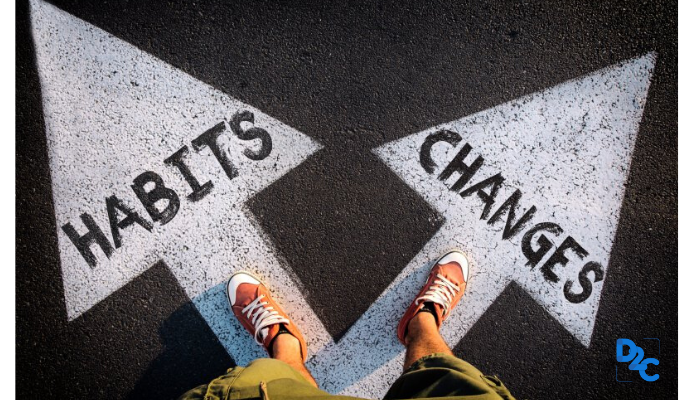Want to break a bad habit cycle? Here is how you can do it!

Habits, as you might know, are an adaptive feature of how the brain works. They can often be a good thing. Habits become an important part of our life. Whether it is your hand automatically switching off the light in your room as you leave, or the route to work you remember from habit. The big question here is, how do you break a habit?
Habits take time, practice, and a lot of repetition to form. So when you want to break a habit, the same holds true for that. Bad habits have a way of interrupting the way you live, and also limiting your ability to succeed. They can cause harm to your health - both mental and physical. They are also a waste of time and energy.
The most important step in the handbook of 'how to break a bad habit' is acceptance. You have to begin by accepting the fact that you have a bad habit. The fact that you are here, means that you are ready to accept that a certain habit is causing you harm. So, here are some maneuvers that might come in handy when you are trying to leave behind a limiting habit.
You cannot simply ‘stop doing it’
The problem with wanting to ‘eliminate’ bad habits, is that you cannot simply throw a habit into the trash can. A bad habit has to be replaced with another habit. We pick up bad habits because they provide us with a sense of ‘benefit’ or ‘relief’ that helps us cope with trigger situations. They address certain needs in your life that will necessitate the idea of ‘replacing’ the habit instead of ‘eliminating’ it.
So first and foremost, choose a substitute. If your bad habit surfaces when you are stressed, start practicing and alternative stress-relieving exercises such as deep breaths, reading a poem you like, listening to a song that calms you down. It is better to replace your habit with a healthier behavior. If you simply ‘stop doing it’, then there will be a trigger situation in which you could relapse into the bad habit.
Distance yourself!
Our physical surroundings often have a deep impact that we fail to comprehend. What you see can cause you to do an action and that visual becomes a cue for a behavior. For example, if you are prone to procrastination, keep yourself away from things, and places that can cause you distraction easily. Your environment could, without your knowledge, be reinforcing your behavior.
It is a simple trick, but very effective! For example, you can try these things if you are habitual of procrastination:
- Start keeping your phone away when you study. The urge to procrastinate while scrolling through media can be very strong. Keep it out of reach.
- Study/work in a place that offers lesser distractions. If you cannot sit in a separate room, have your table face the wall so that you cannot look around at possible distractions.
- Close unnecessary tabs.
Coach yourself, don’t coax yourself
Breaking any habit needs will power. But the failure of breaking the habit cannot be attributed to just lack of will. Instead of trying to coax yourself into changing behavior, try to coach yourself into it. Build a skill that can replace this habit and practice it, little by little. For example, if you are someone who wants to quit the habit of say, drinking too much coffee, and replace it with drinking more water, here’s what you can do:
- When you get the urge to drink a third cup of coffee, remind yourself why you want to quit the habit in the first place
- Put reminders, post-its that spell out the benefits of quitting this habit
- Read through them, give yourself a pep talk and reach for the bottle of water instead of the coffee pot.
This suggestion might not seem to start making a difference immediately. But remember, habits are reinforced by repetition. To coach yourself, is to CAUSE this repetition so that a good behavior replaces the bad one.
Point of view matters!
It is easy to be manipulated by the way you state your intentions. For example, saying ‘I can’t drink coffee’ has a different impact from ‘I don’t drink coffee’. The former implies that you wish to, but cannot, the latter states that you will simply not indulge in drinking coffee.
Saying ‘I don’t’ instead of ‘I can’t’ can influence your habit-changing journey. People who successfully change their habits use this ideology to help their shift to better behavior.
Know your cues
According to a leading neuroscientist, habits have three main components: a cue, a routine, and a reward. Cues are the conditions that result in engaging in the behaviour. For example, the cue to your habit of eating too much sweet could be looking through a bakery window! Avoid the dessert places, if your trigger happens to be simply looking at sweet things.
Similarly, if your cue to a habit of watching TV in between work, is picking up the remote, change the place of your remote. The split second in which you realize that the remote is not in its usual place will give you the reminder needed to pull back from watching television. Cut out your cues and triggers, it will make it easier on you to break a habit, by simply avoiding the things that cause them.
Habits are a part of our life, whether good or bad. You develop them on the way and they stay with you until you decide to break them. Once you have identified your bad behavior, you can start working towards changing it. Stay positive, and remember that failure is a part of this. You might relapse many times but the trick is to keep going.
Some other relevant articles to building your personality
Login to continue reading
And access exclusive content, personalized recommendations, and career-boosting opportunities.
















Comments
Add comment